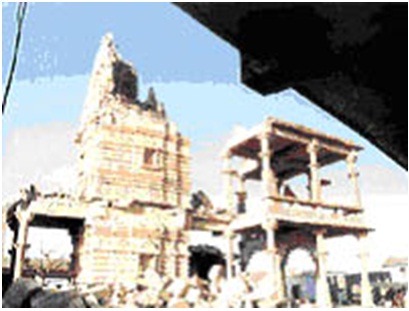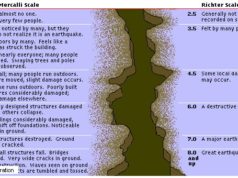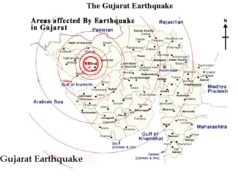Osho once said ‘ Man has the capacity, the intelligence, the freedom to explore and if you have explored the nature properly than you have come home. Nature is your Home.’ Nature affects every dimension of our lives but than whoever build the Heavens must be looking down upon the Earth and must be thinking ‘Gosh! What a mess I have made!’ – this reviving the memories of Noah to feel the ‘Ups and downs’ are just another part of Life, anyway!
Gujarat was struck with horrifying Earthquake terror on India’s Republic Day and the fury of nature yet continues in many parts of the world today with the Global warming & ozone hole.
The Earthquake conjure images of appalling destruction, horrifying death and people made homeless in thousands. Humans cannot abate the fury of the nature as it swirls around to engulf them with its claws. When god made Eden, he created Man but then after, he has to perform endless jobs to balance life on earth. The fate of many victims lies in his hands. Free souls sympathize for the victims caught in the disaster and pray heavenly peace for the departed souls. Let’s build a ray of hope and support a mission to help the stranded people where we can reach them with our little help in the best way we can. Maybe, our little Prayers too, may heal the pain!
Keep the Faith
-Editor, Kidsfreesouls
EARTH QUAKE 2001
KILLER EARTHQUAKE WRECKS HAVOC IN MANY PARTS OF INDIA & PORTIONS OF HYDERABAD IN PAKISTAN – WITH BHUJ AS ITS EPICENTRE, THE EARTHQUAKE HAS CREATED A PANIC AND HAVOC WITH MANY PEOPLE KILLED, HOMELESS AND STRANDED. BHUJ IS WORST HIT FOLLOWED BY AHMEDABAD WHERE THOUSANDS OF PEOPLE FACE THE FURY OF THE NATURE!
WHY EARTHQUAKES? GLIMPSE INTO SCOOP INFORMATION ON EARTHQUAKES
THE RESLESS EARTHQUAKE – NATURE UNLEASHES ARMAGEDDON!
Nothing seems more stable than the ground beneath our feet and nothing more unchanging than the seasons. The Earth’s internal heat keeps the tectonic plates that make up its surface in constant motion. Structural changes are also due to changes in global scale as pollution threatens a dramatic and irreversible warming of the atmosphere. The world’s weather goes to extremes and as humans face the fury of nature, the wrath of gods leaves impressions on the Earth with destructions in forms of Hurricane, Tornado, Earthquakes and so on. The earthquake has wrecked terrible havoc and stranded many a thousands of people homeless to battle against the fate. Scientists long believed the core of the Earth to be smooth, spherical mass of iron, molten on the outside and solid but still astonishingly hot, within. However, 1980s research techniques reveal that the earth is not smooth at all but features ‘valleys’ deeper than the Grand Canyon and ‘peaks’ higher than the Mount Everest. They are the oceans of molten rock. According to the theory of plate tectonics developed over the last 30 years, the Earth’s crust is made up of a series of interlocking, slowly shifting plates. Over millions of years the plates have moved, diverging from, colliding with or grinding against each other, and in the process moving and changing the outline of the continents, creating new areas of the sea bed, building mountains and volcanoes and bringing about earthquakes. The constant moving of the tectonic plates that make up the Earth’s crust builds stress deep underground as the movement of the plate pushes or pulls rock, until eventually it gives way with cataclysmic results. The earthquake involves phenomenal amounts of energy releasing 10,000 times as great as that of the first atomic bomb.
Why Earthquakes occur
The plate tectonics theory says that the earth’s outer shell consists of about 10 large, rigid plates and about 20 smaller ones. Each plate consists of a section of the earth’s crust and a portion of the mantle, the thick layer of hot rock below the crust. Scientists call this layer of crust and upper mantle the lithosphere. The plates move slowly and continuously on the asthenosphere, a layer of hot, soft rock in the mantle. As the plate move, they collide, move apart or slide past one another. The movement of the plates strains the rock at and near plate boundaries and produces zones of fault around these boundaries. The rock becomes locked in place and cannot slide as the plates move. Stress builds up in the rock on both sides of the fault and causes the rock to break and shift in an earthquake. The focus of earthquake lies less than 70 kms beneath the surface though the deepest known focuses have been nearly 700 kilometres below the surface. The point on the surface of the earth directly above the focus is known as the epicenter of the quake where the strongest shaking is usually felt. The violent breaking of rock releases energy that travels through the earth is the form of vibrations called seismic waves which move out from the focus of an earthquake in all directions.
Structural hazards
Structures collapse during a quake when they are too weak or rigit to resist strong, rocking forces. Skyscrapers vibrate wildly due to impact of earthquake. Engineers for building structures should adopt the right techniques. The simpler reinforcement techniques include bolting buildings to their foundations and providing support walls called shear walls. Shear walls, made of reinforced concrete (concrete with steal rods or bars embedded in it), help strengthen the structure and help resist rocking forces. Shear walls in the center of a building, often around a lift shaft or stairwell, form what is called a shear core. Walls may be reinforced with diagonal steal beams in a technique called cross bracing. Also medium sized buildings should be done with devices that act like shock absorbers between the building and foundation. These devices, called base isolators are usually bearings made of alternate layers of steel and an elastic material such as synthetic rubber. Base isolators absorb some of the sideways motion that would otherwise damage a building. Skyscrapers need special construction to make them earthquake resistant. They must be anchored deeply and securely into the ground. They need a reinforced framework with stronger joints that an ordinary skyscraper has. Such a framework makes the skyscraper strong enough and yet flexible enough to withstand an earthquake. Earthquake resistant homes, schools and workplaces have heavy appliances, furniture and other structures fastened down to prevent them from toppling when the building shakes.
Devastating Earthquakes
Historical records of earthquakes before the middle of the 18th century are generally lacking or unreliable. Among the ancient quakes for which reasonably trustworthy records exist are the one that occurred off the coast of Greece in 425 BC, making Euboea an island; one that destroyed the city of Ephesus in Asia Minor in AD 17; one that leveled much of Pompeii in 63; and those that partly destroyed Rome in 476 and Constantinople (now Istanbul) in 557 and again in 936. In the Middle Ages, severe quakes occurred in England in 1318, Naples in 1456, and Lisbon in 1531
The earthquake in 1556 in Shaanxi (Shensi) Province of China, which killed about 800,000 people, was one of the greatest natural disasters in history. In 1693, an earthquake in Sicily took an estimated 60,000 lives; and early in the 18th century the Japanese city of Edo (the site of modern Tokyo) was destroyed, with the loss of some 200,000 lives. In 1755 the city of Lisbon was devastated by a quake and about 60,000 people died, a disaster that figured in the French writer Voltaire’s novel Candide. The shock was felt as far away as the English Midlands. Quito, now the capital of Ecuador, was shaken by an earthquake in 1797, and more than 40,000 people died. In the 20th century, large areas of India, Iran, Japan, Turkey, Armenia, and the Soviet Union have been hit by severe earthquakes. In 1920, 200,000 people died as a result of an earthquake which struck Kansu Province, China (and 70,000 in the same region in 1932); in 1976, 240,000 were killed in T’ang-shan, China. In North America, the San Francisco earthquake of 1906 caused extensive damage and claimed about 700 lives. In 1988 a devastating earthquake struck northern Armenia, killing 25,000 people, and in 1990 50,000 were killed by an earthquake that struck Rasht, Iran. In 1995 the Kobe earthquake in Japan claimed the lives of over 6,000 people and more than 100,000 buildings were damaged.








